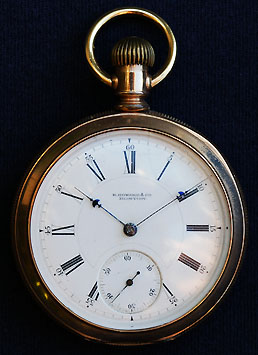

- #E HOWARD WATCH COMPANY BOSTON SERIAL NUMBERS#
- #E HOWARD WATCH COMPANY BOSTON REGISTRATION#
- #E HOWARD WATCH COMPANY BOSTON SERIES#
So, what exactly should you be looking out for? Here are the top 6 things to consider when determining the value of your pocket watch. Perhaps you have inherited an antique timepiece, passed through your family for generations? Antique pocket watches can bring in some serious money, but determining their value can be difficult.
#E HOWARD WATCH COMPANY BOSTON REGISTRATION#
Howard Pocket Watch Movement in Wirstwatch Case Do you need sex without any obligations? CLICK HERE NOW - registration is completely free! For a much more detailed explanation of Howard production records, please visit the NAWCC Pocket Horology web site.E. Our thanks to Clint Geller for his assistance with Howard production dates.
#E HOWARD WATCH COMPANY BOSTON SERIAL NUMBERS#
Also note that serial numbers were not always used sequentially e.g. As a result, one must differentiate the model of the watch in order to properly determine its date of manufacture.
#E HOWARD WATCH COMPANY BOSTON SERIES#
Howard serial numbers are a bit different than some of the other American manufacturers, in that they could have multiple production "runs" going on at the same time, using different series of serial numbers.

Howard Watch Serial Numbers and Production Dates

We'd be glad to talk with you about the repair of your vintage mechanical Howard watch.Į. We're sorry that we can't help with your modern "Howard" watch, which was neither made nor sold by the original Howard Watch Company. We recommend you contact Lacrosse for service questions about your modern E. Howard" brand name is currently owned by Lacrosse Technology which sells several models of "radio-controlled" watch under the Howard name, often sold through ads in magazines. Howard" watch, your watch was definitely NOT made by the original E.

If you have a modern, battery-powered "E. The following case manufacturers are known to have produced gold cases for Howard. & Co." in addition to a maker's mark (see table below). Many case-makers produced cases for Howard watches, often in 14K or 18K gold, and sometimes marked "E. Howard produced watches in sizes G, I, J, K, L and N, which corresponds approximately to size 6, 10, 12, 14, 16 and 18 respectively.īecause Howard sizes were different than those of other American manufacturers, Howard movements will not fit properly in most "standard" American watch cases. By 1869, Howard had progressed from the "N" size movements (approximately 18-size) to the smaller "L" size movements (approximately 16-size). Sizes of Howard watches were designated using the Dennison system of measurement (see table below). For information on your Keystone-Howard watch, please see our Keystone-Howard page. Howard Watch Co., Boston, U.S.A." These watches are commonly called Keystone-Howards. In 1902, the Keystone Watch Case Company purchased the rights to the Howard brand-name, and subsequently produced a line of watches labeled ""E. Howard is NOT the same as Keystone-Howard Howard & Co., Boston."Įdward Howard retired in 1882, but his company continued to sell watch movements in grades and styles established by Howard until 1903. Howard dials were always made of hard enamel, and bore the name " E. Howard was first to use the Reed patented micrometer regulator, and was the first to offer watches adjusted to six positions. The manufacture of key-wind movements was discontinued altogether by 1878. Howard also introduced the first stem-winding watch in 1868, and was probably the first to market such a watch in the USA. Reed's patented barrel was used on early watches, but by 1868, Howard patented a new steel motor barrel which replaced the Reed's barrels in Howard watches. Balances were gold or steel at first, and later bi-metallic compensating balances with gold screws were used. This watch also introduced the more accurate quick-train to the American market. The top plate was made in two sections (split plate) and had six pillars instead of the usual four found in a full-plate watch. By the summer of 1858, Edward Howard produced the first watch of his own design, a watch that was entirely different from previous watches.


 0 kommentar(er)
0 kommentar(er)
